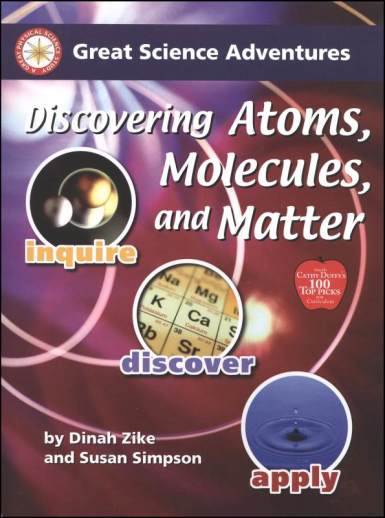We use cookies to make your experience better. To comply with the new e-Privacy directive, we need to ask for your consent to set the cookies. Learn more.
Discovering Atoms, Molecules, and Matter
Hardcopy, 150-page books which include both textual and how-to information plus reproducible pages.
In Discovering Atoms, Molecules, and Matter students will learn about the physical properties of matter, the periodic table, elements, how molecules bond, chemical reactions, and more.
- 24 hands-on lessons appropriate for grades K-8 at different mastery levels facilitating multi-level teaching
- Lots of Science Library Books with information, pictures, and diagrams
- Investigative Loop guides the student through each step of the lab activities with materials lists, questions, and data for students to record
- 3D Graphic Organizers provide a format for students of all levels to conceptualize, analyze, review, and apply the concepts of the lesson
- Teacher Pages include vocabulary words, maps, assessments, and assignments
Items in this section tend to be instructional frameworks, or unit studies with a "core" teaching resource supplemented with additional text and/or activity resources.
What child wouldn't jump at the chance to put together his or her own science program? Well, now they can. Literally. This series, by paper-manipulating guru Dinah Zike and author Susan Simpson, has a very unique way of teaching science. The basic idea behind the series is to put complicated information in a simple-to-understand visual format to ease learning and extend retention. Rather than displaying the information in textbook form with questions at the end of each chapter, this is a much more novel way of presenting the material. For each lesson, students construct a Lots of Science Library Book using the masters provided inside the main book. These small books (2.5" x 4" when finished) contain all the information, pictures and diagrams needed for that particular course of study. To help the students conceptualize, analyze, review and apply the knowledge gleaned from these student-made books, lessons will have at least one activity which involves the construction of 3D Graphic Organizers, a sort of cut-and-create model from the back of the main book. These activities focus on a skill such as compare and contrast, observation, describing a process or explaining functions and most of the activities include writing about the subject matter. Lessons also include vocabulary, objectives, teacher instructions, assignments, and enrichment activities. The enrichment section is found at the end of each lesson and has activities to expand upon concepts taught in the lesson, provide a foundation for further study or integrate the study with other disciplines.
The activities don't stop there, though. After all, what is a science program without a lab? For the most part, the labs require regular household items and sometimes incorporate other things, like the Graphic Organizers, into the process. To ensure that the labs are effective and practical, the Investigative Loop is used to guide the student through each step of the lab: posing a question or concept, research and/or predictions, starting a procedure, making observations, recording the data, drawing conclusions and/or applications, communicating the conclusions, sparking new questions, beginning a new loop and so on. And there are still more activities: design your own experiment, have an ongoing project in the works or end the particular book with a cumulative project. Every book in the Great Science Adventures series has 24 lessons, which should each take 1-3 days to complete. The Lots of Science Library Books pages and the graphics pages are reproducible.
If you are looking for a program where students are spoon-fed information from a textbook and the teacher needs little preparation time, look elsewhere. This is the essence of a hands-on program. For those who learn best by doing, this approach is well worth considering. - Zach
| Product Format: | Softcover Book |
|---|---|
| Brand: | Common Sense Press |
| Author: | Dinah Zike & Susan Simpson |
| Grades: | K-8 |
| ISBN: | 9781929683253 |
| Length in Inches: | 11 |
| Width in Inches: | 8.5 |
| Height in Inches: | 0.5 |
| Weight in Pounds: | 1.3 |

